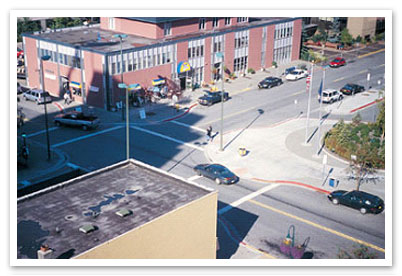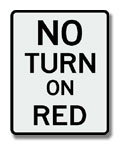Right-of-Way
Right-of-way is the right of one vehicle, vessel, or person to take precedence over another.
In other words, right-of-way determines who gets to continue on their path-of-travel and who must give way, or yield, to the other person.
All roadway users—not just those in motor vehicles—share the responsibility of legally accepting or yielding the right-of-way.
Right-of-way rules exist to remove confusion and add clarity to the driving experience. Have you ever been walking down a hallway when suddenly, you're about to run into someone?
You take a step to the side, but they take a step to the same side, and then you both take a step to the same side again, and it’s awkward for everyone involved?
The same thing can happen on the road, except instead of just being awkward, it can be deadly.
Here are a few key terms to keep in mind while learning about right-of-way:
- Right-of-way: The right of one vehicle, vessel, or person to take precedence over another.
- Yield: To “give way” to another vehicle or person on the roadway, or to give the right-of-way.
- Merge: To come together. When one road comes together with another, it merges. When you drive your car up the onramp, you merge onto the freeway.
- Signals: Lights at intersections.
- Signs: Signs posted along the road such as stop signs, yield signs, directional signs, etc.
A high percentage of teen driver crashes happen at intersections. This makes sense, because there’s a lot going on at intersections, like cars turning and crossing in front of oncoming traffic.
Some intersections are controlled by traffic signs and signals which instruct you when to accept or yield the right-of-way.
These are called "controlled intersections." Take a look at the video below to learn more about controlled intersections.
Uncontrolled intersections are intersections without traffic signs or signals. When you come across these intersections, proceed with caution and yield the right-of-way to the vehicle on your right.
Any vehicle that has entered the intersection on your right or is approaching the intersection from your right should go first.
If the road to your right is clear, or if the vehicles approaching from that direction are far enough away, you may proceed through.
 Uncontrolled Intersection
Uncontrolled Intersection
If you are given the right-of-way, be sure there are no cars approaching from the left before you drive through the intersection. Even if you’re following every traffic law perfectly,
you can’t always count on other roadway users to do the same.
You may legally have the right-of-way, but another car may not yield to you when they’re supposed to, so always be cautious before proceeding through an intersection.
Take a look at the video below to learn more about uncontrolled intersections.
At a "T-intersection," stop first, then yield the right-of-way to the vehicles already traveling on the through street.
Right-of-Way and Left Turns
When turning left:
- Engage the left turn signal from the proper turning lane.
- Yield the right-of-way to pedestrians, emergency vehicles, and other vehicles in the intersection.
When turning left at an intersection with a green light, you must always yield the right-of-way to vehicles coming straight through from the other direction, unless you have a green arrow giving you the right-of-way.
You never want to turn left in the face of a car going straight through an intersection. You will cut them off, and possibly cause a very dangerous collision.
When turning left at a flashing yellow arrow, slow down and yield the right-of-way to oncoming traffic and pedestrians.
If you have a flashing yellow arrow and there is no oncoming traffic, you do not need to stop before executing your left turn.
The idea behind these flashing yellow arrows is to give more cars an opportunity to safely turn during each signal cycle.
Right-of-Way and Right Turns
At an intersection with a green light, you have the right-of-way when turning right.
At an intersection with a red light, you must stop and yield the right-of-way to oncoming traffic when turning right. If there’s a No Turn on Red sign, you may not turn while the light is red.
 "No Turn on Red" Sign
"No Turn on Red" Sign
If you are making a right turn and a bicyclist is approaching on the right, you should yield the right-of-way and let the bicyclist go through the intersection first before making a right turn.
Remember to use your turn signal.
Right-of-Way and Pedestrians
A pedestrian is a person on foot, either walking or running. There are laws that define how and where pedestrians should walk, but as a driver you should always look out for them.
In general, you should yield the right-of-way:
- When a pedestrian is in an unmarked crosswalk on the driver’s side of the roadway and there aren’t any traffic control signals.
- When a pedestrian enters a crosswalk before the traffic light changes.
- When a pedestrian is leaving or entering a street or highway from an alley, building, private road, or driveway.
- When a pedestrian is entering an intersection with a flashing yellow arrow.
- To a person with disabilities.
Additional Right-of-Way Rules
Here are some additional rules of right-of-way to consider:
- Railroad Crossings: Always yield the right-of-way to any approaching train or railroad equipment.
Trains are much bigger than cars and travel at much fast speeds. If your vehicle came in contact with a train, the train would win every time.
- Roundabouts or Traffic Circles: Yield the right-of-way to traffic already in the roundabout, including pedestrians and bicycles.
- Funeral Processions: You must yield the right-of-way to all vehicles in the funeral procession. Vehicles participating in a funeral procession should have their headlights and hazard lights turned on.
Never drive between vehicles in an organized funeral procession unless instructed to do so by a law enforcement officer.
- Emergency Vehicles: Always give these emergency vehicles the right-of-way when they are sounding a siren or bell or flashing a red light.
Make sure that you’re never playing music so loudly that you can’t hear approaching sirens. Pull to the right edge of the roadway and stop, giving them room to pass.
- School Buses: If you are approaching a school bus from either direction with its flashing red lights engaged and its stop arm extended, you must stop until: the school bus has resumed motion,
you are signaled by the bus driver to proceed (in this case, proceed with extreme caution), or the red lights are no longer flashing and the stop arm is no longer extended.
Wait a moment before driving again, as little kids are unpredictable and may run into the street with no warning.
Without the rules of right-of-way, our roadways would be a chaotic and dangerous place. Make sure you're familiar with the general rules of right-of-way that we've discussed here, as well as the specific laws in your state.
Take a Course to Learn More
If you enjoyed this article and are interested in learning more about driving-related topics, you should check out our courses on www.safe2drive.com.
We offer courses in a variety of topics including Defensive Driving and Driver Education. In addition to teaching you how to be a safe driver, our courses
can help you dismiss a ticket, get your driver license, or even get an insurance discount. We also have courses specifically tailored to mature drivers (i.e., drivers
age 55 and older) for insurance discounts.